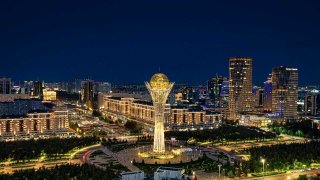Central Asian Integration Is In America’s Interest
The incoming Trump administration should encourage Central Asian states to take ownership of regional cooperation initiatives.
Central Asia is a strategically significant region abundant in resources and economic potential. It can and should emerge as a hub for positive and profitable U.S. engagement. Securing critical minerals, accessing uranium to support the nuclear sector, and opening new markets for American companies are all on the horizon. Enhanced regional cooperation, connectivity, and collaboration among Kazakhstan, Uzbekistan, Tajikistan, Turkmenistan, and Kyrgyzstan (the C5) could foster local prosperity and advance American interests. A unified Central Asia is less likely to succumb to Russian or Chinese attempts to “divide and rule” and more likely to partner with the West for support and inspiration.
C5 integration has taken various forms, including the Central Asian Union (CAU), established in 1993 at the request of Kazakhstan’s founding president, Nursultan Nazarbayev. Later, it became the Central Asian Economic Union, which operated from 1994 to 2004 without Turkmenistan as a member. The United States first sought to formalize cooperation with the C5 through the C5+1 annual diplomatic summit to promote collective action in 2015. As the Trump administration prepares to enter the White House, it should support and empower Central Asian integration.
Nazarbayev, who will celebrate his eighty-fifth birthday later this year, recognized this in 1992, outlining a multi-vector foreign policy as necessary for Kazakhstan and the region as a whole. His successor, President Kassym-Zhomart Tokayev, continues this policy. With greater cooperation between themselves and the United States, locally integrated Central Asian countries could more effectively exercise their joint policies. Their neighbors—Russia, China, Iran, and Afghanistan—cannot be disregarded. Rather, the C5 must diplomatically balance these neighbors’ immediate interests against one another while simultaneously attracting European and American investment.
The C5 can only capitalize on their neutrality if they diversify partners and solidify their national identities by balancing their relations with external powers. This requires more than just formal political cooperation. Cultural and economic cooperation through other IGOs, such as the Organization of Turkic States and the Conference on Interaction and Confidence Building Measures in Asia (CICA), provides a valuable forum for broad cooperation between governments, businesses, and civil society in the region.
Greater unity between the Central Asian countries necessitates infrastructure and logistics improvements, reductions in border controls and tariffs, and harmonized regulations and standards. Additionally, trade between the United States and Central Asia requires reliable and secure routes. The Middle Corridor, intended to span the Central Asian steppe, the Caspian Sea, the Caucasus Mountains, and the Black Sea, presents this opportunity. Considering disruptions to other trade routes, such as by Houthi rebels for those passing through the Red Sea or Russia, the Middle Corridor can become an increasingly attractive option when readily available, and U.S. companies can become involved in making it happen.
Deepening cooperation between the United States and Central Asian countries faces several challenges. First, if it does not emphasize cooperation, the ties with America will complicate relations with Russia and China. Washington should not be seen as trying to supplant Moscow’s and Beijing’s influence in Central Asia. Still, it can present an opportunity for Central Asian countries to have a wider variety of options in the global market and help prevent any one country from economically dominating Central Asia.
Archaic trade restrictions that impede long-term projects, namely the Jackson-Vanik Amendment, have hindered U.S.-Central Asia cooperation. As part of the Trade Act of 1974, passed by Congress and signed into law by President Gerald Ford, this legislation denied permanent normal trade relations with non-free-market economies that restricted emigration rights, including the Soviet Union. While the USSR had maintained a long-standing policy of severely restricting emigration in general, its policies refusing to let its Jewish population emigrate while simultaneously crushing any and all public expressions of Judaism led to the growth of a movement to free the Soviet Jews that eventually resulted in the passage of Jackson-Vanik. Ultimately, the Iron Curtain was lifted in 1989, and most Jews from the USSR struggling to get out finally managed to leave for Israel and the United States.
When the Soviet Union finally collapsed in 1991, Kazakhstan, under Nazarbayev, lifted emigration restrictions and quickly moved away from the USSR’s repressive anti-religious stance, seeking to establish religious tolerance. It inaugurated the Congress of World Religions in 2003. At the same time, Uzbekistan was far more restrictive in this regard until the death of its first president, Islam Karimov, in 2016. Considering progress in the region and the potential for fostering robust trade, Jackson-Vanik is now an impediment to future progress that should have been discarded long ago.
The incoming Trump administration should encourage Kazakhstan and Uzbekistan to take ownership of an integration initiative, as both see themselves as regional leaders. Countries that are more apprehensive about their relations with the United States, like Tajikistan and Turkmenistan, should also be welcome to join. Still, Washington must acknowledge that not all C5 countries will participate equally. Having the willing C5 countries take the lead may help reduce the fears in Moscow and Beijing.
Amid Russia’s brutal invasion of Ukraine, raging conflicts in the Middle East, and tensions surrounding China, Central Asia has been overlooked despite its proximity to all three regions. While a realist U.S. foreign policy, likely resurgent under a Trump administration, is rightly centered around maintaining relations with great powers, Washington must recognize the area’s economic and logistical importance. Now is the time for Washington to get proactive about furthering progress toward a more integrated Central Asia.
Alex Little is a Master of National Security Policy Candidate at Pardee RAND Graduate School specializing in Russian and Central Asian affairs and a Young Voices contributor.
Image: YuTphotograph / Shutterstock.com.

